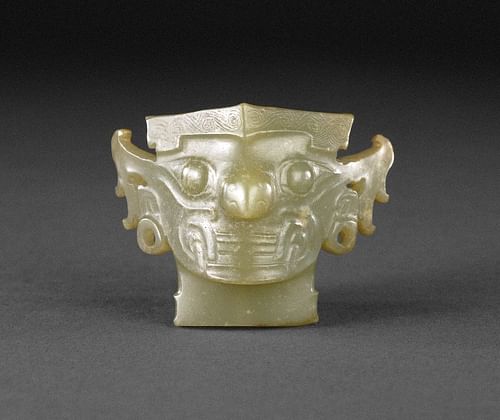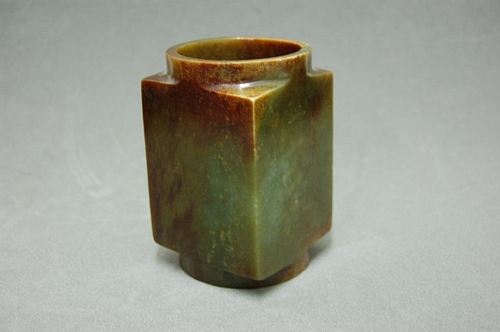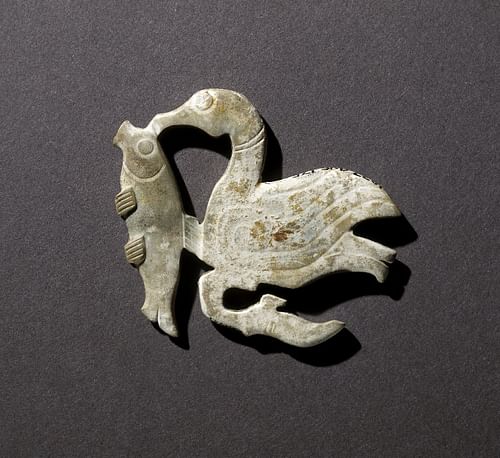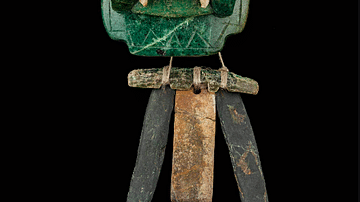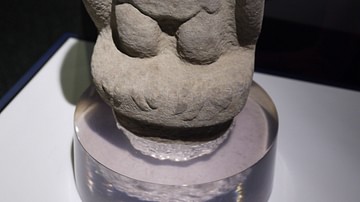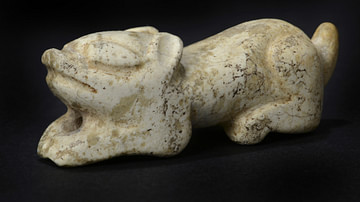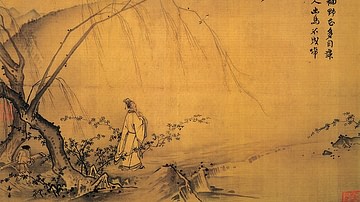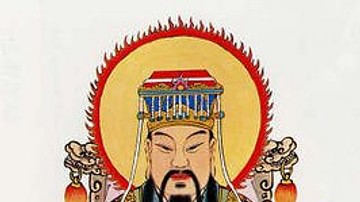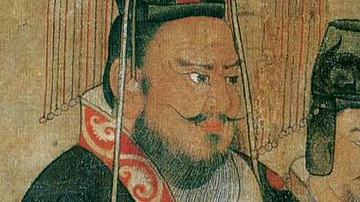Jade (nephrite) was regarded as the most precious stone in ancient China, and it symbolised purity and moral integrity. Prized for its durability and magical qualities, the stone was laboriously carved and polished into all manner of objects from jewellery to desk ornaments. Jade was especially used for ritual objects such as the bi disc and zong (cong) tubes, both of which are of unknown function.
Mining & Working
Jade, in the case of China, refers to the mineral nephrite, the hardest and rarest hard stone. There is another mineral with that name, jadeite, but this was unknown to the Chinese prior to the 18th century CE when it was imported from Burma. Nephrite comes in various shades of green and other colours depending on the percentage of iron content in the stone and other trace elements. The principal source was in the Xinjiang region but it is likely others sources, once exhausted, have disappeared from the historical record. The Khotan region of Central Asia is another known source of the stone in antiquity. Jade was first used from c. 6000 BCE and green long remained the preferred colour, but during the 5th and 4th century BCE there was a fashion for white jade with a brown tinge and again in the 1st century BCE when a pure white jade became available from central Asia following expansion under the Han Dynasty (206 BCE - 220 CE).
Excavated from mountains and picked up in riverbeds - and so known as 'the essence of heaven and earth', the stones could not be cut by a metal knife, and so they were shaped using a cord and sand acting as an abrasive before being more precisely carved using a drill and then polished. Jade is a hard stone and working it with primitive tools would have required a great deal of time and effort, which, of course, only added to its value. Early pieces have engraved linear designs, but over the centuries a more sophisticated appearance was achieved by carving the jade so that the object had many contours, niches, and points which were highly polished.
Associations & Significance
The ancient Chinese considered jade the most precious and most beautiful natural material. It was carved as early as the Neolithic period (c. 3500-2000 BCE) when it was used to make sacrificial and ritual objects, especially in the Hongshan and Liangzhu cultures. However, it was the aesthetic quality of jade and an increasing association with moral ideas of purity and goodness ascribed to it by Confucian thought that ensured the precious stone would continue for centuries as the most desired decorative material. No doubt due to its high value, it also became associated with the aristocracy and it was regarded as virtuous for gentlemen to adorn their houses, and especially their writing desks, with aesthetically pleasing yet functional objects carved from jade. Another strength of jade was the belief that, as it was considered indestructible, it imparted some sort of immortality on its owner, and for this reason, jade objects were frequently buried with the dead.
The 2nd-century CE Chinese dictionary Shuo-wen chieh-tzu gives the following definition of jade and its believed attributes:
Jade is the fairest of stones. It is endowed with five virtues. Charity is typified by its lustre, bright yet warm; rectitude by its translucency, revealing the colour and markings within; wisdom by the purity and penetrating quality of its note, when the stone is struck; courage, in that it may be broken but cannot be bent; equity, in that it has sharp angles which yet injure none. (Dawson, 229)
Jade was so highly valued that it was influential in other areas. Ceramics of the 8th century BCE frequently copied the green hues of jade, as did later celadon wares. Even in religion and mythology jade made its impact, with one of the major Chinese gods, the Jade Emperor, being named after the precious stone.
Jade Objects
Large rectangular tablets were carved in the Neolithic period, many of which replicate forms of tools and weapons. Found in tombs, their function is unknown. Another common object is the ceremonial axe which copies other stone versions but made from impractically thin jade cut into a rectangular shape with a single hole.
Another early use of jade, during the Shang Dynasty (1766-1111 BCE), was to make chimes as the resonance of the stone was highly esteemed. In the same period, seals for the orifices of the body in burials were made from the stone. Surfaces of jade pieces were carved much like contemporary bronze work with linear designs such as abstract meanders, spirals, and hooks. A typical object made in the stone was the ritual cups of unknown purpose known as zong (aka cong). These have a circular tube-form inside a square, are sometimes decorated with notches and small circles, and can be up to 30 cm high and 15 cm across.
Another common jade ritual object, again of uncertain function, is the bi, a disc with a central hole cut out and sometimes with the outer edge decorated with notches, which was produced during the Shang and Zhou Dynasty (1111-221 BCE). Bi are often found placed on the waist or chest of the deceased. Also common to this period are jade bracelets, miniature human, monster, and bull masks, halberd blades, and miniature tools such as sickles, knives, combs, and scoops which frequently have holes made in them, presumably for suspension from a waist belt as indicated by the position of their discovery on the deceased in tombs. Finally, there are decorative plaques which are often crescent shaped and known as huang. They may sometimes be carved to represent stylised birds and dragons or snakes but maintain their overall crescent form.
By the 8th century BCE the skill and range of the jade carver are greater and wider, illustrating the sculptor is freer and more confident in pursuing his ideas. Animal figurines were popular and were represented in the round or as flat plaques showing owls, falcons, swallows, geese, ducks, parrots, cormorants, fish, tigers, elephants, deer, hares, cicadas, monkeys, buffalo, dogs, tortoise, horses, and bears. Decorative plaques for personal adornment, combs, hairpins, and tiger-tooth pendants were also produced.
By the 5th century BCE there are many more secular objects carved from jade and evidence that new and better drills were being employed. Dragon plaques with the creature forming a loose S-shape, protruding dragon decorations, regular pitted decoration of bi, and double-tiger head motifs are now common features. Green, brown, and white jade are all used and there is even one bi example in purple-blue nephrite.
By the beginning of the Han Period (206 BCE) some pieces begin to show signs of a circular cutting drill and iron tools but with a lower quality finish than previously, which suggests pieces were starting to be made quicker and on a larger scale of production. Another feature of Han jade sculpture is the use of flaws and impurities in the jade to make them part of the sculpture.
Jade is now used for ornaments, jewellery, figurines of humans, miniature landscape sculptures, chopsticks, sheaths to protect long fingernails, writing desk paraphernalia (ink stones, brush pots, and brush rests), belt buckles and even small items of furniture. A 113 BCE tomb at Mancheng (south of Beijing) is especially interesting as it contained a royal couple wearing jade 'suits' - complete body coverings made from over 1,000 small squares of jade, joined with silver and gold wiring.
Jade, besides being used as a precious material in its own right and without any additions, was frequently used as an inlay in other precious goods such as gilded bronze or pure gold jewellery, cups, and bowls.
Jade faced increasing competition for the attention of art lovers and aesthetes from developing crafts such as painting, ceramics, and lacquer work but the stone continued to hold its allure thanks to its mystical associations. The largest ever jade sculpture, Yu the Great Taming the Waters, is a massive depiction of a Qing landscape carved in 1787 CE by a team of sculptors who took over seven years to complete and it illustrates jade's continued hold on the Chinese imagination which remains firm even today.

